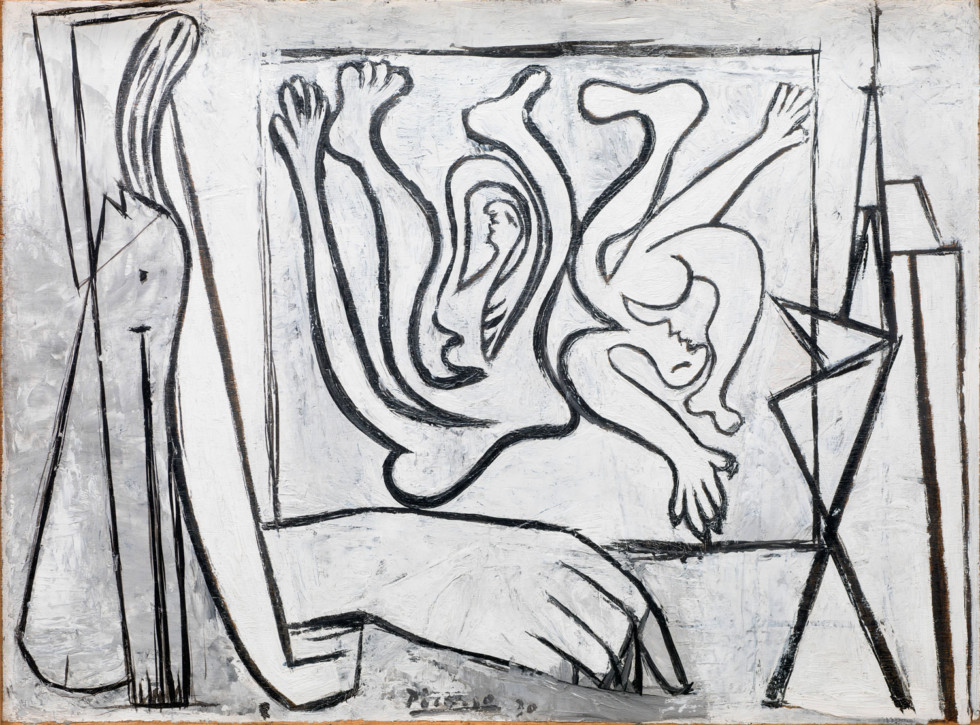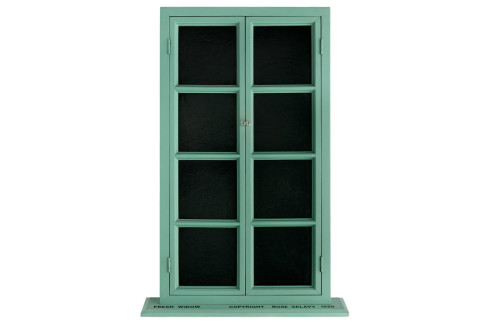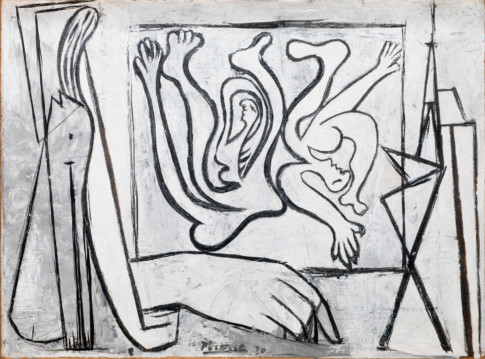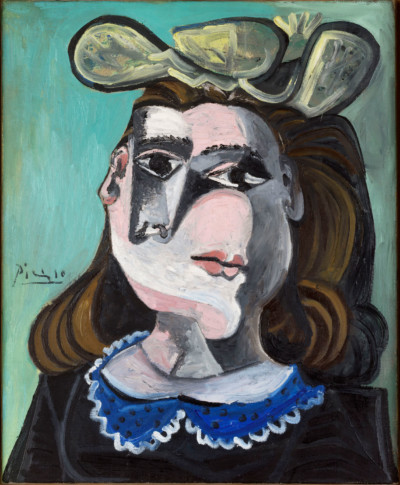
Pablo Picasso, Le Peintre (The Painter), 1930 © Succession Picasso / Bildupphovsrätt 2017
Picasso in the Collection
The first works were already acquired in 1921 through a purchase and a donation to Nationalmuseum, which up until the opening of Moderna Museet in 1958, was also entrusted with collecting, preserving and exhibiting contemporary art. Three prints were bought on this occasion: La dance, Salomé and Buste d’homme (all dating from 1905). The drawing Acrobate (1904) was donated as a bequest by Ester Lindahl.
The next acquisition took place three years later in 1924 from Svensk-Franska Konstgalleriet [the Swedish-French Art Gallery], whose director founded the Föreningen för Konst [Association for Art]. It was this organisation and Föreningen för Nutida Konst [the Association for Contemporary Art] that provided the basis of Moderna Museets Vänner [the Friends of Moderna Museet] when the organisation was established in 1953. The motifs of the prints Femme au bord de la mère and Femme couchée (both dated 1924) are related to the painting La source (1921), which was donated to the museum in 1970 by Grace and Philip Sandblom. In 1930 the watercolour S:t Antonius (1908) was bought through the agency of the artist Georg Pauli (1855–1935).
The first acquisition of an oil painting, La femme à la collerette bleue (1941), was made in 1946. This was also purchased through the Swedish-French Art Gallery in connection with the exhibition Peintres de Paris. The work has become one of the museum’s “classics” and it was believed for a long time that it was a portrait of Dora Maar. More recent research has shown that the portrait has certain similarities instead to works depicting a model named Inez. The collection does, however, contain another portrait of Dora Maar, La femme aux yeux noirs (Dora Maar) (1941–43), which was bequeathed to the museum in 1989 by Gerard Bonnier, together with another painting, Le peintre (1930), and three sculptures, Tête de femme (Fernande) (1910), Femme Boisgeloup (1931) and Le bras (1959). Gerard Bonnier was an active member of the Friends of Moderna Museet and his donation was part of a considered plan for the museum’s future collection. The delay before Picasso’s paintings found their way into the collection was partly due to prevailing political attitudes to art and also the personal standpoints of the museum’s staff. Gregor Paulson and Ragnar Hoppe, who were both curators in Nationalmuseum’s engravings gallery during the first half of the 20th century, had a more radical outlook than their contemporary colleagues in the galleries for paintings. During Otto Sköld’s period as Director about ten etchings on hard ground were acquired in 1952. One example is La femme qui pleure III (1937), in which the motif alludes to the desperate figures depicted in Guernica (1937).
Two prints, Sueño y Mentira de Franco (Planche I and II), that are also linked to Picasso’s painting Guernica, were purchased from Sandberg’s bookshop in 1938. In 1951 another purchase was made from Sandberg’s comprising twelve etchings from the Vollard Suite (1927), whose main theme was sculptors/ painters and models. Another interesting purchase was made in 1942 from the merchant and collector Ivan Traugott. This comprised four etchings linked to Picasso’s suite of works on the theme of acrobats – like Le saltimbanque au repos (1905). These etchings offer an excellent complement to Famille d’acrobates avec singe [Acrobat Family] (1905), which forms part of the collection of the Gothenburg Museum of Art, the museum which next to Moderna Museet has the largest holding of Pablo Picasso’s works in Sweden. In 1958, Nell Walden, who was a member of the artistic circle surrounding the journal Der Sturm in Berlin, donated works by a number of artists, one of them a print by Picasso entitled Femme nue (1913–14). This print had been issued by Daniel-Henry Kahnweiler, Picasso’s publisher and owner of the art gallery at which his works were sold.
The painting Joueur de guitare (1916) was donated to the museum in 1950 by Rolf de Maré (1888–1964), art collector and founder of the Swedish Ballet in Paris, which he ran from 1920 until 1925. Rolf de Maré’s entire collection was bequeathed to Moderna Museet in 1966 in his will, although parts of it had already been sold to the museum.
Two Picasso paintings were bought in 1964, Buste de femme (1907) and La demoiselle (1929). Both of these paintings, the collage Bouteille, verre et violon (1912–13) and the sculpture Déjeuner sur l’herbe (1962), were included in the purchase made with funds acquired in connection with the exhibition Önskemuseet [The Museum of Our Wishes] (1963–64). The initiative for this exhibition came from Ulf Linde together with the Friends of Moderna Museet and the project resulted in a nonrecurring grant from the Swedish state of SEK 5 million. This made it possible to enlarge the museum’s collection with 36 works by eminent Modernist artists. Buste de femme had been purchased from Galerie Beyeler in Basle and La demoiselle, through the agency of Etude Etienne Ader. The poet Tristan Tzara, one of the leading figures in the Dada movement and later married to Greta Knutson-Tzara, was an early owner of the collage Bouteille, verre et violon, from 1912–13. The museum bought it from Mme Claude Sarrut-Tzara, the former wife of Tzara’s son Christophe. The museum’s collection also includes a sketch for the group of sculptures Déjeuner sur l’herbe as well as a proposal on how it could be sited (both from 1964). The sketch is on cardboard and was donated in 2007 by the Norwegian sculptor Carl Nesjar (b.1920), who in 1967 had created the monumental sculpture in sandblasted concrete and subsequently sold it to the museum. The proposal is a photo collage with details in chalk and ball-point pen, signed by both Pablo Picasso and Carl Nesjar.
In connection with the fiftieth anniversary of Moderna Museet (during a banquet on 30 May 2008) Eva, Karl Otto, Peggy, Pontus and Åke Bonnier donated the painting Tête de femme (1957) to the collection. This donation also included a collection of 52 black-andwhite photographs by David Douglas Duncan (b. 1916) in which he traced the creation of the painting. This donation is up to now the most recent acquisition of a work by Pablo Picasso for the Moderna Museet collection in Stockholm.
Compiled by Annika Gunnarsson and Anna Tellgren



